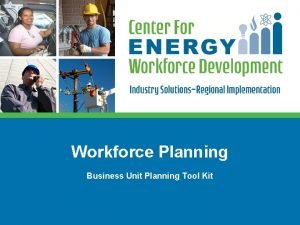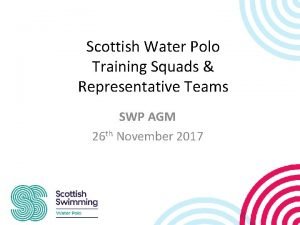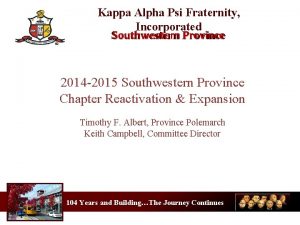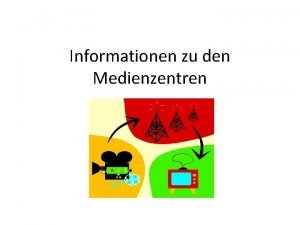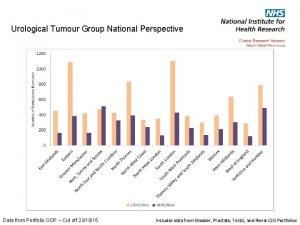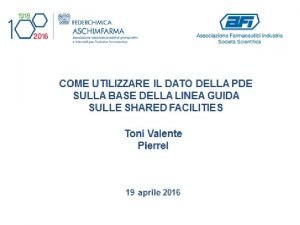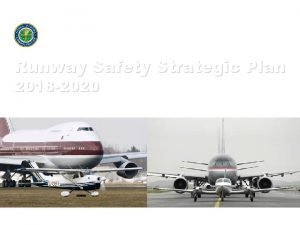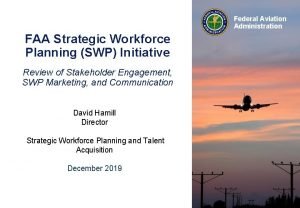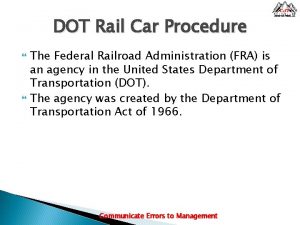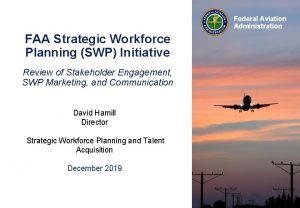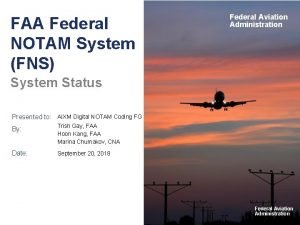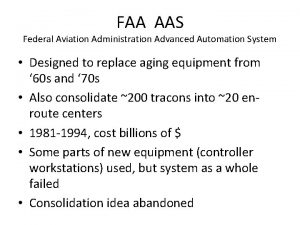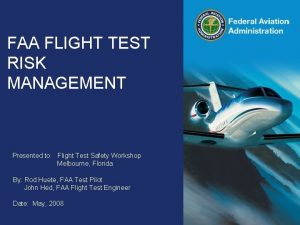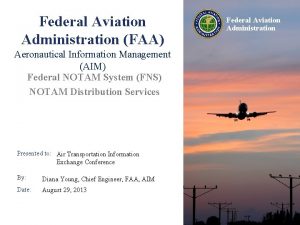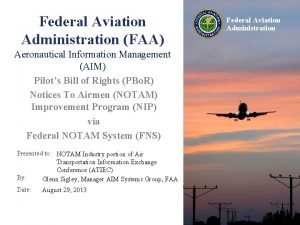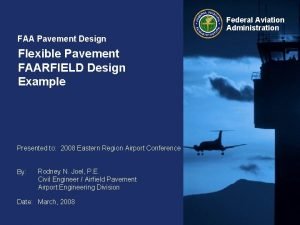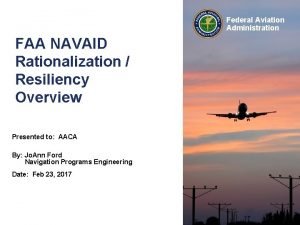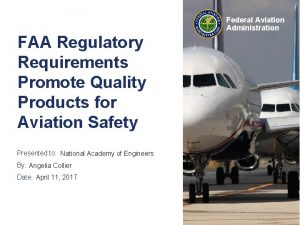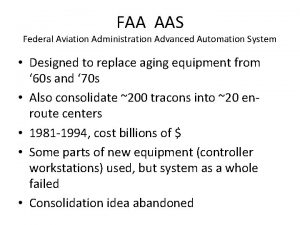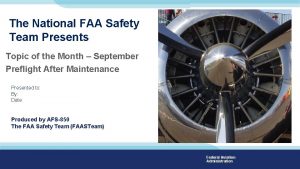Federal Aviation Administration FAA Strategic Workforce Planning SWP

















- Slides: 17

Federal Aviation Administration FAA Strategic Workforce Planning (SWP) Initiative Review of Stakeholder Engagement, SWP Marketing, and Communication David Hamill Director Strategic Workforce Planning and Talent Acquisition December 2019 Federal Aviation Administration 0

Overview of SWP Engagement • What are Change Drivers? • What is Strategic Workforce Planning? - SWP Defined - Enterprise-wide vs. LOB-specific WFP • Overview of the FAA Strategic Workforce Planning Initiative - Problem Statement Key Benefits Communications Framework Timeline • Next Steps • Appendix: Strategic Workforce Planning Initiative Step-by-Step - Baseline Assessment and Supply Analysis Workforce Planning Maturity Assessment Future State Analysis Gap Analysis and Workforce Planning Model Action Plan for Gap Remediation Federal Aviation Administration 1

Then and Now circa 2017 circa 1996 Federal Aviation Administration 2

Change Drivers SWP Background and Change Drivers • NAPA Review of FAA Personnel System (January 2017) The study team identified weaknesses in three HR areas: 1. Classification and management of HR-related positions (business partners); 2. Workforce planning; and 3. Labor negotiations. Recommendation #8: to support AHR’s ability to develop Agency-wide strategies, FAA should take steps to strengthen the existing workforce planning processes, including clear assignments of responsibility and authority. • OMB Memorandum on Workforce Reform (April 2017) - Create a lean, accountable, more efficient government that works for the American people; and - Align the Federal workforce to meet the needs of today and the future rather than the requirements of the past. Federal Aviation Administration 3

FAA SWP Initiative FAA SWP Problem Statement • Lack of an Agency-wide and strategic approach to workforce planning limits FAA’s ability to optimally align human resources with strategic priorities. • How can AHR best support our customers with strategic planning and acquiring the right quantity and quality of talent to meet their strategic priorities? ØThe greatest opportunity to impact quantity, quality, and alignment of talent acquisition is on the “front-end” of the process, which includes strategic workforce planning. Federal Aviation Administration 4

What is SWP? Strategic Workforce Planning Defined “Strategic Workforce Planning is a dynamic process to define and plan for the workforce needed to achieve the mission, priorities, and business strategies of the Department. ” 1 Set Strategic Direction Evaluate and Update Strategic Workforce Planning Lifecycle Right People Right Time Right Place Right Price Right Results Implement Action Plan 1 DOT Strategic Workforce Planning 101 Briefing Analyze Workforce Develop Action Plan Federal Aviation Administration 5

What is SWP? Example: Agency-wide SWP Perspective on Recruiting Mission Critical Occupations Strategic Priority • FAA has a mission imperative to recruit and retain an optimal mix of mission critical occupations (MCOs) to effectively and efficiently address current and emerging strategic goals and priorities. SWP Analysis Questions • What are the common factors (internal/external) that influence or drive the workforce requirements for MCOs? • How do we identify and analyze those factors on an enterprise-wide scale to ensure that MCO hiring is not stove-piped, and instead is strategicallyplanned and integrated across the organization? Federal Aviation Administration 6

FAA SWP Initiative Primary Benefits of FAA SWP Initiative The FAA SWP Initiative is a comprehensive, standardized, datadriven, risk-based approach to assess the current FAA workforce, model the agency’s future workforce needs, and implement a strategy to close identified workforce gaps. The SWP Initiative will enable the FAA to better anticipate, plan for, and respond to changes to mission requirements, workforce needs, talent supply, and critical competencies. The SWP Initiative will help the FAA make better-informed decisions related to workforce size, composition, and current and future skill requirements across the entire agency. Preparing the FAA to align the right people, in the right place, at the right time Federal Aviation Administration 7

FAA SWP Initiative Timeline AHR has built internal capability, supported by Booz Allen Hamilton, to conduct a comprehensive Strategic Workforce Planning Initiative covering the FAA’s enterprise-wide workforce—inclusive of all LOBs/SOs—focused on the next 3 -5 years. The initiative kicked off on October 3, 2018. Activity Baseline Assessment and Supply Analysis Workforce Planning Maturity Assessment Future State Analysis Gap Analysis and Workforce Planning Model Action Plan for Gap Remediation Implementation and Monitoring of Action Plan Oct 2019 Nov Dec Jan Feb Mar Apr May Jun Jul Aug Sep Oct Nov… Project paused during shutdown 2018 Federal Aviation Administration 8

BAR Highlights – External and Internal Drivers Collected and examined internal and external change drivers to determine their impact on FAA’s future workforce needs EXTERNAL DRIVERS • Safety of the NAS and the General Public − Major Aviation Events and Incidents − Rapid Innovation and Safety • Technology and Expansion of the NAS − Regulating New Aviation Technologies − Commercial Space − Democratization of the NAS • Political Considerations − Privatization − Government Shutdowns and Continuing Resolutions − Government Oversight • Labor Trends − Interest in Federal and FAA Employment − Competition for Talent − Aviation Careers INTERNAL DRIVERS • Risk-Based Decision Making − Data Analytics to Power Safety Decisions • Next. Gen − Modernization of the NAS (e. g. , TFMS, TBFM, ERAM, ADS-B, SWIM, PBN) • Legacy Systems Maintenance − Continuity of Operations − Knowledge Management • Automation − Process Automation & Standardization • Generational Shifts − Workforce Retirement − STEM Talent • Outsourcing − Balancing Contractor Footprint − Designees and Delegated Organizations • Bargaining Units − Collaboration with Unions for WF Development Federal Aviation Administration 9

Sample: Work Changes – Partnerships Federal Aviation Administration 10

Appendix • Strategic Workforce Planning Initiative Step-by-Step - Baseline Assessment and Supply Analysis Workforce Planning Maturity Assessment Future State Analysis Gap Analysis and Workforce Planning Model Action Plan for Gap Remediation Federal Aviation Administration 11

Baseline Assessment and Supply Analysis Conduct an enterprise-wide environmental scan 2018 Activity O 2019 N D J F M A M J J A S O Baseline Assessment and Supply Analysis Workforce Planning Maturity Assessment Generate descriptive statistics (e. g. , personnel counts by occupation, location, level, etc. ) and identify key workforce trends Future State Analysis Gap Analysis and Workforce Planning Model Action Plan for Gap Remediation Examine internal and external drivers of change (e. g. , technology, budgetary, and demographic trends) to determine their impacts on FAA’s future workforce needs Federal Aviation Administration 12

Workforce Planning Maturity Assessment Assess FAA’s current workforce planning capability across LOBs/SOs Conduct interviews/focus groups with key leadership to determine extent of workforce planning use throughout the agency 2018 Activity O 2019 N D J F M A M J J A S O Baseline Assessment and Supply Analysis Workforce Planning Maturity Assessment Future State Analysis Gap Analysis and Workforce Planning Model Action Plan for Gap Remediation Use Workforce Planning Maturity Model to assess FAA’s readiness to establish and implement strategic workforce planning Federal Aviation Administration 13

Future State Analysis Identify up to three potential future state scenarios 2018 Activity O 2019 N D J F M A M J J A S O Baseline Assessment and Supply Analysis Workforce Planning Maturity Assessment Determine how FAA’s strategic priorities, environment, technologies, and operational norms might look in 3 -5 years Future State Analysis Gap Analysis and Workforce Planning Model Action Plan for Gap Remediation Document critical needed skills and associated business drivers to project the future-state workforce for each of the scenarios Federal Aviation Administration 14

Gap Analysis & Workforce Planning Model Identify critical gaps between the current and future state workforce 2018 Activity O 2019 N D J F M A M J J A S O Baseline Assessment and Supply Analysis Workforce Planning Maturity Assessment Prioritize the gaps based on their potential risks, impacts to mission critical operations, and strategic or business requirements Future State Analysis Gap Analysis and Workforce Planning Model Action Plan for Gap Remediation Build a workforce planning model providing centralized storage, interaction, and visualizations to understand FAA workforce data for the future state scenarios Federal Aviation Administration 15

Action Plan for Gap Remediation Identify strategies to close the gaps identified 2018 Activity O 2019 N D J F M A M J J A S O Baseline Assessment and Supply Analysis Workforce Planning Maturity Assessment Develop an Action Plan to address the prioritized gaps and mitigation strategies to address risks Future State Analysis Gap Analysis and Workforce Planning Model Action Plan for Gap Remediation Produce high-level Roadmap for developing strategic workforce planning capability tailored to FAA’s unique operating environment Federal Aviation Administration 16
 Strategic workforce planning maturity model
Strategic workforce planning maturity model Federal aviation administration purpose
Federal aviation administration purpose Workforce tool kit
Workforce tool kit Scenario planning workforce planning
Scenario planning workforce planning Tems swp
Tems swp Kappa alpha psi southwestern province
Kappa alpha psi southwestern province Medienzentrum kaiserslautern
Medienzentrum kaiserslautern Odp/swp
Odp/swp Ema/chmp/cvmp/swp/169430/2012
Ema/chmp/cvmp/swp/169430/2012 Faa runway safety
Faa runway safety Faa strategic plan
Faa strategic plan Fha new deal relief recovery reform
Fha new deal relief recovery reform Federal railroad administration train car
Federal railroad administration train car Strategic planning vs tactical planning
Strategic planning vs tactical planning Strategic workforce
Strategic workforce Zero based forecasting
Zero based forecasting Workforce planning nedbank
Workforce planning nedbank Workforce planning conference 2018
Workforce planning conference 2018


